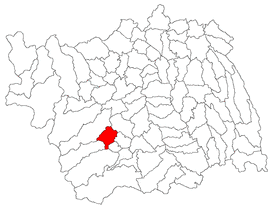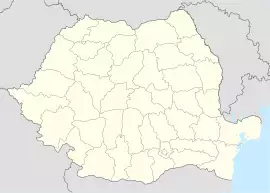Târgu Ocna | |
|---|---|
Town | |
 Location in Bacău County | |
| Coordinates: 46°16′48″N 26°37′12″E / 46.28000°N 26.62000°E | |
| Country | |
| County | Bacău |
| Government | |
| • Mayor | Ștefan Șilochi[1] (PSD) |
| Area | 48.90 km2 (18.88 sq mi) |
| Population (2011)[2] | 11,300 |
| • Density | 230/km2 (600/sq mi) |
| Time zone | EET/EEST (UTC+2/+3) |
| Vehicle reg. | BC |
| Website | orasul-targuocna |
Târgu Ocna (Romanian pronunciation: [ˌtɨrɡu ˈokna]) is a town in Bacău County, Romania, situated on the left bank of the Trotuș River, an affluent of the Siret, and on a branch railway which crosses the Ghimeș Pass from Moldavia into Transylvania. Târgu Ocna is built among the Carpathian Mountains on bare hills formed of rock salt. In fact the English translation of Ocna is salt mine.
Târgu Ocna's main industry is salt production, as it is the largest provider in Moldavia. Other industries include wood processing, coal mining, steel producing, and petroleum-based industries.
The town administers two villages, Poieni and Vâlcele.
| Year | Pop. | ±% |
|---|---|---|
| 1900 | 8,033 | — |
| 1912 | 7,989 | −0.5% |
| 1930 | 12,588 | +57.6% |
| 1948 | 9,796 | −22.2% |
| 1956 | 11,227 | +14.6% |
| 1966 | 11,647 | +3.7% |
| 1977 | 12,603 | +8.2% |
| 1992 | 16,071 | +27.5% |
| 2002 | 14,184 | −11.7% |
| 2011 | 11,300 | −20.3% |
| Source: Census data | ||
Natives
- Gabriela Adameșteanu, writer
- Sorin Antohi, political scientist
- Miron Grindea, journalist
- Dan Iuga, pistol shooter
- Costache Negri, writer
- Ion Talianu, actor
- Traian Vasai, painter
References
- ^ "Results of the 2016 local elections". Central Electoral Bureau. Retrieved 3 April 2020.
- ^ "Populaţia stabilă pe judeţe, municipii, oraşe şi localităti componenete la RPL_2011" (in Romanian). National Institute of Statistics. Retrieved 4 February 2014.
- . Encyclopædia Britannica (11th ed.). 1911.

